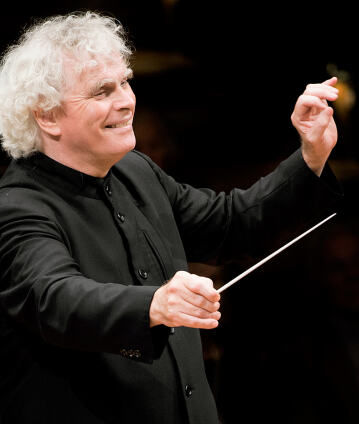Simon Rattle conducts Beethoven’s Symphonies Nos. 6 and 8

Even though Beethoven often felt alien among his fellow humans, he was close to nature. He manifested his enthusiastic connection to life in the countryside most impressively in the colourful natural scenes of his Sixth Symphony. The humorous Eighth behaves in a less balanced way; its Finale gave Louis Spohr the impression that someone was sticking his tongue out in the middle of a conversation.
That for Beethoven, as for the “Sturm und Drang” poets and thinkers, nature was associated with a state of internal peace as a symbolic antithesis to civilization, is readily apparent in his Sinfonia pastorale. With the famous work, he created a light idyllic landscape of bucolic cheerfulness: the music does not press forward in a targeted fashion, urging onwards. Instead, the symphonic events are governed by images of nature moving within themselves, from the “Arrival in the countryside” to the “Scene by the brook”, from the “Merry gathering of country folk” to stormy weather.
But Beethoven was not interested in creating musical illustrations, as he stated in the well-known line “more the expression of feeling than painting”. This is because although there were definitely contemporary models for the subject of the Pastorale – for instance, the symphony Le Portrait musical de la Nature by the Stuttgart organist, conductor and composer Justin Heinrich Knecht, composed in 1782-83 – Beethoven understood the “Pastorale” here as a symbol for a higher world order into which man is integrated harmoniously.
Before the Sixth Symphony, Sir Simon Rattle conducts Beethoven’s Eighth, whose reception was characterized by terms like “lightheartedness” and “humour” early on – and with good reason: in Anton Schindler’s recounting, the Allegretto Scherzando reflects the mechanical works of metronome inventor Johann Nepomuk Mälzel, since the main theme reverts to the so-called Mälzel Canon WoO 162, which Beethoven composed in the spring of 1812 at a companionable farewell dinner to the words “Ta ta ta ta … lieber Mälzel, leben Sie wohl, sehr wohl! Banner der Zeit, großer Metronom” [Ta ta ta ta ... dear Mälzel, fare thee well, fare thee very well! Banner of the time, great metronome]. And Louis Spohr felt that the Finale with its rapidly changing ideas was like someone sticking out his tongue in the middle of a conversation, while Carl Dahlhaus wrote of a “humoristic demonstration of the impossibility of a solution”. Constantin Floros appropriately called the movement “probably the most brilliant example of the art of the imprévu from the time before Berlioz.”
© 2015 Berlin Phil Media GmbH
Artists
Our recommendations
- Simon Rattle conducts film scores at the Waldbühne
- Simon Rattle conducts Brahms, Schoenberg, Berg and Webern
- Sir Simon Rattle and Dianne Reeves at the 2003 New Year’s Eve Concert
- Simon Rattle conducts Berlin school orchestras
- Simon Rattle conducts Schumann and Fauré
- Krystian Zimerman and Simon Rattle perform Bernstein’s “The Age of Anxiety”